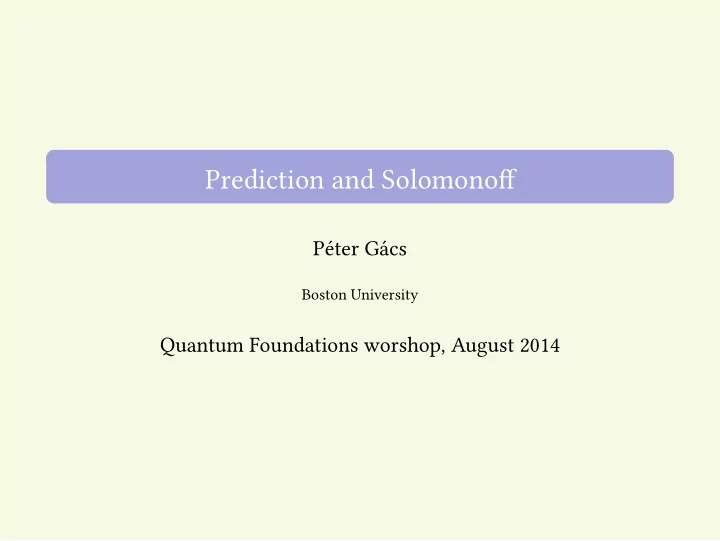

Prediction and Solomonoff Péter Gács Boston University Quantum Foundations worshop, August 2014
Inductive inference Much of the discussion on the first day of the workshop dealt with the problem of inductive inference in general—quantum physics and cosmology did not seem relevant. There is an approach to inductive inference that I felt was ignored, and which can be seen a refinement of Occam’s Razor. In its generality, this approach is not trying to decide the “true” model to be used for prediction: it is just trying to be (nearly) as good as the best possible predictors that we humans (or computers) can produce. Solomonoff achieved (something like) this by chosing a universal prior in a Bayesian framework. It is related to the prior Charlie talked about yesterday, but is not the same.
The probabilities Turing machine T , one-way binary input tape. One-way output tape. Experiment: input is an infinite sequence of tosses of an independent unbiased coin. (Monkey at the keyboard.) M T ( x ) = P { outputted sequence begins with x } . The quantity M T ( x ) can be considered the algorithmic probability of the finite sequence x . Dependence on the choice of T : if T is universal of the type called optimal then this dependence is only minor (Charlie explained this). Fixing such an optimal machine U , write M ( x ) = M U ( x ) . This is (the best-known version of) Solomonoff’s prior.
The formula Given a sequence x of experimental results, M ( xy ) M ( x ) assigns a probability to the event that x will be continued by a sequence (or even just a symbol) y . Attractive: prediction power, combination of some deep principles. But: incomputable. So in applications, we must deal with the problem of approximating it.
Principle of indifference In Solomonoff’s theory, Laplace’s principle is revived in the following sense: all descriptions (inputs) of the same length are assigned the same probability.
The prediction theorem Solomonoff’s theorem restricts consideration to sources x 1 x 2 . . . with some computable probability distribution P . Let P ( x ) = the probability of the set of all infinite sequences starting with x . The theorem says that for all P , the expression M ( x 1 . . . x n b ) M ( x 1 . . . x n ) gets closer and closer to P ( x 1 ... x n b ) P ( x 1 ... x n ) (with very high P probability). The proof relies just on the fact that M ( x ) dominates all computable measures (even all lower semicomputable semimeasures, like itself).
All the usual measures considered by physicists are computable. Here is another example to illustrate the variety. Example Take a sequence x 1 x 2 . . . whose even-numbered binary digits are those of π , while its odd-numbered digits are random. Solomonoff’s formula will converge to 1 / 2 on the odd-numbered digits. On the even-numbered digits, it will get closer and closer to 1 if b equals the corresponding digit of π , and to 0 if it does not.
Recommend
More recommend